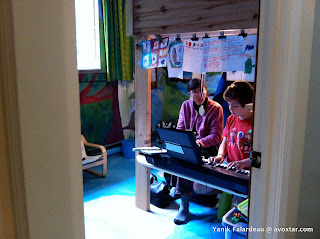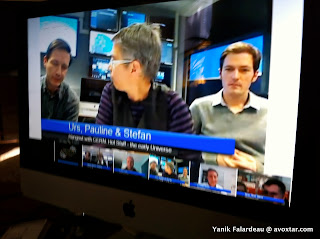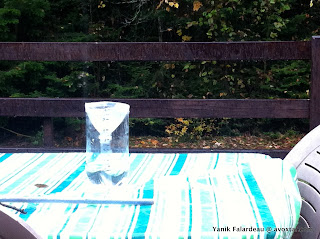Hey Guys!
Have you ever created slime, made water turn into snow, or even coloured a leaf without touching it? Well I have and I'm going to show you all this and even more!
Here are this year's science experiments!
You guys probably remember the
Air Pressure Experiment I did at the beginning of the year. If you don't, click the link to go check it out!
I watched a live hangout with the scientists from CERN and learned a little about how the Large Hadron Collider works.
I also watched Felix Baumgartner skydive for 39 km!!!
Electricity
I experimented with electric circuits and used a potato to make a battery.
I watched the last Venus transit of the 21st century as it happened.
Exotarium
I visited the Exotarium and learned about reptiles and all kinds of other creatures.
The Science Center
I always love visiting the Science Center.
The Farm
I visited a farm and had fun catching rabbits.
Pluviometer
I made a pluviometer or rain gauge and measured the rainfall.
Coloured Leaf Experiment.

Theres also the Coloured Leaf Experiment. This was done by placing a leaf in a jar filled with coloured water. Then the leaf absorbs the coloured water and it becomes the colour of your food colouring. This helps us to see how the leaf drinks the water for nourishment. For this experiment you need: a glass or jar, food colouring, and some kind of leaf. We tested lettuce and cabbage. Cabbage worked the best.
Polymers

I also made some gooey slime to learn about polymers! This experiment was fun because the slime alters between being solid or liquid, therefore we could make different shapes and textures by adding more or less water. You can find information on how to make your own experiment on the
Science Bob Site.
The Water Cycle
I also created a chart to show how the water cycle works! Although I skipped the last phase (The Runoff) of the water cycle because I didn't know it. I still showed some interesting points about the water cycle.
It starts at the fist phase: Evaporation or Transpiration. Evaporation is when water from either oceans, lakes or rivers evaporates from their respective bodies of water and fly up to the sky. the second phases (Condensation) is when the water crams up together making a cluster of little droplets to form clouds. The third phase (Precipitation) is when the clouds become big and wet (cumulonimbus), they all evacuate making rain.
Critters and Bugs

We found some cool bugs again this year and we researched what they were! In the picture above, we see a Coleoptera called a leaf beetle. I found it on a rock.
By the way, my dad recently made a ladybug habitat because we want to attract more ladybugs to our garden.
I also found a large hairy spider on a piece of bark. It's called a
Fishing Spider or Dolomedes Tenebrosus and it is semi aquatic. They can bite but aren't poisonous. At first when we saw this spider I was freaked out since it was 2 inches wide!
Light Photography
I love light photography!
This is created by opening your shutter so that more light comes in your camera, but before I briefly explain this, heres a link to a video that explains in detail
Light Painting. Light painting happens when you open your shutter and draw something with a light source. To create this you need 4 things: a camera with an option to open the shutter wide open, a tripod if you have one, a light source, and some darkness. This specific painting was created in my basement and I used finger lights to create the colours. We took 3 separate pictures and then we brought it into photoshop to add all the elements together.
Baking bread in the Kitchen of Science!
We made braided bread to learn about yeast! Braided bread is basically normal bread dough, but before you put it in the oven you braid it. This bread taste a lot like regular home made bread, but has a bit more salt and the inside is soft.
The ingredients to make homemade bread are: 1 cup of water, about 2 cups of flour, 2 tea spoons of
yeast, a pinch of salt, and a pinch of sugar. When you combine water and flour it makes the dough, when you combine the yeast and the sugar the yeast feeds on the sugar and ferments to which makes the dough rise and the salt is for taste. Making bread is chemistry at its finest!

Science Magazines!
I've read about 50
Débrouillards in the last 3 years and I learned all kinds of interesting stuff! Les Débroulliards is a scientific magazine that talks about all kinds of topics like new scientific inventions and discoveries. They also have tests, fun facts, and there's also a comic strip. Its a great way to learn about science in a fun way. Here's a picture of this month's edition.
Making Snow!
Do you know how to make snow? I do now!!!
This winter, we tried the water to snow experiment! For this exciting experiment you need: very cold weather and a pot of boiling water. What happens is that the boiling water freezes at the contact of cold air, so it turns into snow.
We also tried the experiment with cold water and saw that the cold water doesn't turn into snow.
Spring time came around and we planted a few sunflower seeds.
We also experimented with planting a few different kinds of stumps of vegetables. Like :
Bok Choy
Celery
And carrots, but we forgot to take a picture. They all grew!
Failed but fun experiments :
We tried to make a bouncy egg by putting an egg in vinegar for a few days to dissolve the shell. My mom dropped it before it was bouncy enough and it broke. It was pretty funny.
I adopted two wooly bear caterpillars, called Norm and Wormpole, and made a habitat for them to spend winter in our veranda. We thought they would become moths in the spring, but they didn't make it. Sorry guys.
Hope you liked this overview of some of the science experiments I did this year!
Bye!











































































